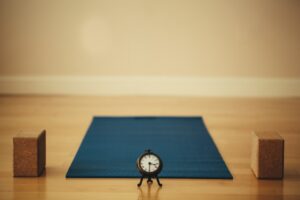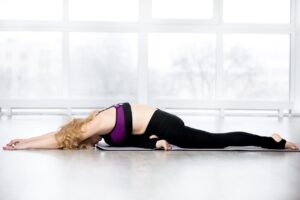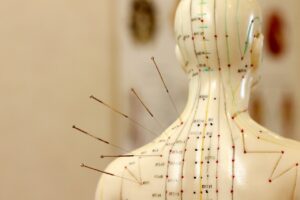The Role of Time in Yin Yoga
By Bernie Clark
August 5, 2024

In the world of yoga, where movement and breath are often synchronized in fluid sequences, Yin Yoga offers a contrasting yet complementary approach. This gentle, meditative practice focuses on holding poses for extended periods, allowing practitioners to explore deeper layers of their body and mind. At the heart of Yin Yoga lies a powerful yet often underestimated element: time. Unlike dynamic styles of yoga, where poses are held briefly, Yin Yoga invites practitioners to linger in stillness, holding poses for several minutes. This deliberate use of time allows for profound physical, emotional, and energetic transformations. But what exactly happens when we remain in a posture for an extended duration? How does time influence the body’s tissues, fluids, and healing processes? This article explores the transformative power of time in Yin Yoga, uncovering its role in enhancing flexibility, promoting healing, and facilitating a deeper connection with oneself.
Viscosity and Tissue Relaxation
Fluids have a property called viscosity: liquids like water that have low viscosity flow easily out of your teacup.1 However, honey pouring into your cup to sweeten your tea flows slowly. Honey is more viscous than water. Our tissues and the fluids in our body can also be very viscous. It takes time for honey to flow and it takes time for our inner tissues to respond to long-held stresses. Fascial tissues, like our ligaments and joint capsules are viscoelastic. This means that if they are subjected to a large, transient stress, they respond like very stiff springs. They do not elongate quickly and this protects our joints from sudden forces. However, if you apply a long-held, static stress to these same tissues, they first undergo a relaxation process which slowly lengthens them2 and then when that stage is complete, they begin to creep and elongate further. When the internal force within the tissue equals the external force, no more elongation occurs. If the external force is larger than the internal resistance, rupture could occur. For this reason, in Yin Yoga, we do not seek maximal stress in any posture. We seek an optimal amount of external stress or load in order to allow an appropriate amount of force on the tissues. Due to this stress and elongation the body triggers an adaptation response to slowly remodel the tissues, making them stronger and longer.
The Impact of Acupuncture
Have you had an acupuncture session? How long were the needles left in? An acupuncturist leaves the needles for a long time! They don’t just jab you, count to five, and then take the needles out. It takes time for the needles to have an effect. Why?
Helene Langevin, a professor and researcher at several American universities, investigated what happens at a cellular level when acupuncture needles remain in the body.3 Her team discovered that when a long-held stress is applied to our tissues (by inserting and rotating the needles so that they grab onto the collagen fibers beneath the skin), cells in our fascia, called fibroblasts, react by changing shape and secreting chemical messages which signal other cells.4 Typically, acupuncture needles are left in the body for 20 to 30 minutes and this gives time for these cells to react to the physiologic stress. They are the most commonly found cells in our fascia. According to Dr. Langevin, “fibroblast … reorganization is a rather slow process, taking several minutes, and therefore would occur in response to sustained changes in tissue length such as changes in posture and body positions.” In other words, it takes time, not just for acupuncture needles to have an internal effect on our tissues, but also for postures to generate these effects.
It takes time for the cells inside our fascia, like fibroblasts and their cousins myofibroblasts, to react to stresses. Holding a stress for 5 breaths will not affect them any more than keeping an acupuncture needle in for 5 breaths would. In Yin Yoga, we do not stay in one pose for 20 or 30 minutes, but we do accumulate stresses in a targeted area for that long. Consider a class where you held Butterfly for 5 minutes, then did 5 minutes of Caterpillar, then maybe Straddle for 5 or 10 more minutes. In total you may have experienced 15 or 20 minutes of a flexion stress along the spine and into the hips. Similarly, when a therapist performs acupressure massage, the pressure is held for several minutes at a time. It takes time for the cells to react to this physical stress.
Water Dynamics and Thixotropy
Another effect that may occur with a constant stress over time is a change in the flow and the state of water. This is known as thixotropy, which is defined as “the property of becoming less viscous when subjected to an applied stress”. Robert Schleip, a famous fascia researcher at the University of Ulm in Germany has written frequently on this topic. He notes that “fascial tissue is predominantly made up of free moving water [also called “bulk water” or water in the “sol” state] as well as bound water molecules [water in the “gel” state]. During loading, the free moving water is pushed out similarly to squeezing a sponge. With a release that follows; this area is increasingly rehydrated with fresh water that comes from the blood plasma.“5
Too much bulk water can lead to pathologies, such as chronic inflammation.6 But, even within the bound water, free radicals and other toxins can build up. They become trapped within this highly viscous, gel-like form of water. Fortunately, long-held static pressure can transform the gel-like water into bulk water, this is the progress known as thixotropy, and then the freely flowing water can be filtered through the lymph system. After a while, the clean new bulk water is re-transformed back into a bound state.
The slow movement of fluids within our tissues is called “interstitial flow”. It can happen within bone and cartilage as well as other connective tissues.7 This can be modulated by fibroblasts which exert tension upon the scaffold of fascia which surrounds, invests and bounds our tissues. During acute inflammation, fibroblasts relax allowing a swift increase in the flow of water to the region, causing edema or swelling. Conversely, fibroblasts can tighten their grip and reduce swelling. In this way, they act like a sponge; by stretching or compressing tissues fibroblasts can send water out of the connective tissue and make the area more supple. Later, water is re-absorbed and a new equilibrium is reached. The same effect can be achieved through manual massage therapies. This is one technique used to dissolve adhesions within the connective tissue and improve the supply of oxygen and nutrients.8 All these techniques involve applying a compressive or tensile stress to the tissues and letting it linger long enough to stimulate the change in water state and allow it to flow into the lymph system.

Time is More Important than Intensity
Exactly how long a stress should be maintained varies from person to person and depends upon which tissues are being affected. One study looked at the amount of time and stress to optimally heal damaged tissues. The study evaluated stresses that resulted in a variety of tissue elongation (3%, 6%, 9% and 12% lengthening), and different time periods over which the stress was held (1, 2, 3, 4 and 5 minutes). The conclusion was that the longer the period of time and the lower the degree of stress, the faster healing occurred.9 This is a valuable guideline to follow in our yoga practice: we do not need maximal stress! Time is more important than intensity.
There is a therapy called Static Progressive Stretch (SPS) which is used to help patients regain lost range of motion in a damaged joint while decreasing pain, stiffness and swelling. It is used with patients who have undergone surgery or trauma that required immobilization of a joint. The stresses are maintained for 30 minutes, and there are multiple sessions each day.10
Studies of SPS have found that maintaining a long, static stress at the end range of motion improves joint mobility while decreasing inflammation and pain, and with no significant risk to the patient.
Once again, holding stresses for long periods of time can be very therapeutic. It takes time for the tissues to fully elongate, for the water to change state and flow out of the tissues and for the body to stimulate a healing response. Stress is important: too much is not ideal but no stress can be equally bad for the body. More important than the amount of stress is to allow the stress to linger. Time is the magic ingredient.
Summary
Time is indeed the magic ingredient in Yin Yoga, offering a gateway to profound transformation within the body and mind. By embracing extended holds, practitioners tap into the innate wisdom of their bodies, allowing tissues to gradually relax, rehydrate, and adapt. This practice not only enhances flexibility and joint health but also fosters a meditative state that encourages introspection and emotional release. The cumulative effects of sustained stress on tissues stimulate healing responses, making Yin Yoga a powerful tool for both physical and mental well-being. As we embrace the stillness and patience required in Yin Yoga, we learn to appreciate the subtle yet profound changes that time can bring. Whether you are new to this practice or a seasoned practitioner, remember that in Yin Yoga, time is not just a measure but a medium through which healing and growth occur. As you settle into each pose, allow time to work its magic, and discover the depths of transformation that lie within.
___________________________
[1] To learn about viscosity, elasticity and viscoelasticity from a yoga perspective, please read the article A Viscoelastic Primer for Yin Yogis.
[2] Internally, the collagen fibers that make up most of our fascial tissues like ligaments, tendons and joint capsules are arranged in a cross-hatched alignment with cross-links joining the major strands together. Like a net when pulled, the orientation of these fibers change and eventually the fibers all line up in the direction of the applied force. It takes time for this effect to occur. Carla Stecco, a fascia researcher at the University of Padova in Italy states 90% of the relaxation occurs within the first minute of stress and almost 100% occurs within four minutes for the fascial tissues in the lower leg, the crural fascia. See Stecco C, Pavan P, Pachera P, De Caro R, Natali A. Investigation of the mechanical properties of the human crural fascia and their possible clinical implications. Surg Radiol Anat. 2014 Jan;36(1):25-32. doi: 10.1007/s00276-013-1152-y. Epub 2013 Jun 21. PMID: 23793789.
[3] For biography of Helene Langevin, please check out her Wikipedia page.
[4] See Helene Langevin’s May1, 2013 article in The Scientist call The Science of Stretch.
[5] See Robert Schleip’s conversation at http://www.fascialfitness.net.au/articles/robert-schleip-talks-about-fascial-fitness/
[6] “In healthy fascia, a large percentage of the extracellular fluid is in a state of ‘bound water’ (as opposed to ‘bulk water’). .. Much pathology, such as inflammatory conditions or the accumulation of waste products, tends to go along with a shift towards a higher percentage of bulk water within the ground substance. Indications by Sommer and Zhu (2008) suggest that when fascia gets squeezed like a sponge and subsequently rehydrated during exercise, some of the previous bulk water zones may then be replaced by bound water molecules.” https://www.equinestudies.nl/wp-content/uploads/2020/10/The-Living-Matrix-article.pdf
[7] Around 8 liters of interstitial fluid flow through our lymph system every day. See chapter 4.53 Extracellular Matrix by Boris Hinz in Fascia: The Tensional Network of the Human Body, 2nd Edition, Elsevier 2022, (page 281).
[8] For further details, please see chapter 4.5 Fluid Dynamics in Fascial Tissues by Guido Meert in Fascia: The Tensional Network of the Human Body, 2nd Edition, Elsevier 2022, (page 294 – 298).
[9] From Duration and Magnitude of Myofascial Release in 3-Dimensional Bioengineered Tendons: Effects on Wound Healing by Thanh V. Cao et al in J Am Osteopath Assoc. 2015;115(2):72-82: “Documented clinical outcomes associated with MFR include improved physiologic function, reduction of pain, and increased range of motion in the affected joint. Our previous findings revealed that modeled MFR applied in vitro inhibits the cytotoxic effects of fibroblasts, alters fibroblast actin architecture, and induces the expression of various anti-inflammatory and growth factors. We have also shown that MFR downregulates inhibitory factors on protein kinase C and phosphoinositide 3-kinase to sensitize fibroblasts to nitric oxide and improve wound healing. Recent data from our laboratory have also shown that in a 3-dimensional environment, fibroblast cytokine secretion is dependent on MFR strain duration and magnitude, suggesting a correlation between physiologic response and dosed MFR.”
In this study the researchers found that a strain of 3% is ideal. Stresses above that level, which creates a strain of 9% or 12% (which is a lot!), can cause worse problems, but a stress resulting in only a 3% strain can accelerate healing. The longer the stress is applied the better. The lengths of time varied from 0, 1, 2, 3, 4, or 5 minutes, and was then slowly released back to baseline. This, in our Yin Yoga context, means less effort and longer holds is better. They concluded, “Longer duration of MFR resulted in rapid decreases in wound size.”
[10] See the article Static Progressive Stretch and Yin Yoga by Bernie Clark at https://yinyoga.com/static-progressive-stress-and-yin-yoga/

